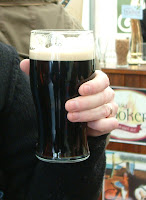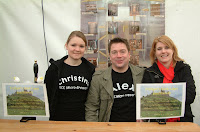The Irish beer calendar is a short one and mostly concentrated in the latter half of year, with
Hilden in August, the
GIBF in October and CAMRA NI's
Belfast festival in November. The main event, however, is the first of the year and happens on Easter Saturday and Sunday at the Franciscan Well brewpub in Cork. This is where the nation's craft brewers gather to sell their wares side-by-side and meet the drinking public. This year there were stalls from Hilden, Hooker, Carlow, White Gypsy, the University College Cork Pilot Brewery and the 'Well itself.

Whitewater had just sent some bottles along, and The Porterhouse phoned in a keg of their Oyster Stout but left it to the hosts to serve it. Unfortunately there was a supply problem with the new Dingle brewing company (Beoir Chorca Dhuibhne) so I didn't get to try their beers.
For the second year, the
Irish Craft Brewer contingent among the festival-goers used the opportunity to
award prizes to the best beers available, and this year the top gong went to a cask version of the Franciscan Well's Purgatory pale ale. I had it in its kegged incarnation
last year, and quite liked it. On cask, however, I was blown away. It was superbly balanced with big mandarin fruit flavours sitting comfortably next to a sherbety hoppy bite, all attached to a full smooth body. A deserving winner and hopefully we'll get to see more of this.

A runner-up award went to Messrs Maguire Imperial, which I have already raved about
at length. The MM brewer is about to launch his own range of bottled beers under his new White Gypsy brand. He says that, the market for Irish craft beer being what it is, most

of this will go straight to export. It's a shame, but I'm depending on the usual suspects in the retail drinks trade to get hold of at least a few cases of these for the locals. This stand was also selling
MM Best, a beer which does the festival circuit in the UK and beyond, but is rarely seen in Ireland. The pub where it's made used to have a regular cask ale (called Pale, if I recall correctly) but it, and its beer engine, disappeared some years ago. Best is a light-bodied golden session ale with a slightly astringent bitterness. All of the cask beers were being served through sparklers and I used this one to decide my opinion in
The Great Sparkler Debate. Having tasted it with and without the plastic tap attachment (picture, right), I confess to not being able to ascertain much difference.

Third place went to last year's champion Galway Hooker. As the only winning beer produced on a year-round basis, Hooker clings to its premier position in the pantheon of Irish craft beers. Still daring and still fresh even after a couple of years on the market. As
I mentioned on Friday, their Irish Coffee Porter was made for this event and it was available in both keg and cask varieties. I didn't try the kegged one to see how it worked with the right gas mix, but the cask one was definitely a different beer to the one I was drinking in the Bull & Castle. The foamy head carried all the coffee essence that I thought was missing from the keg version last week. Fuller, smoother, and altogether more flavoursome. It could be that there's some truth to this notion of cask beer being somehow better than keg...
Another cask beer walked off with the prestigious Beer of the Festival award, decided by popular acclaim rather than any formal voting procedure.

This was Carlow's
Druid's Brew, made especially for the Easter festival each year and modelled here by the lovely Cormac. It's a powerfully bitter stout with a real back-of-tongue dry tanginess in addition to bags of full-on stout roastiness. Its texture is fascinating, being very similar to the sort of creamy smoothness you get with nitrogenation. This, I guess, is the effect the Guinness scientists were going for when they developed nitro beer back in the '50s.
UCC's Pilot Brewery had two beers on (though not when this picture was

taken).
Frithjofs is a lager which looks for all the world like a Belgian witbier: cloudy and pale yellow-green. It has you thinking of lemons before even taking a sip. In reality it's not really lemony, but it does have a tangy fruitiness to it, to my mind more like a light German weiss than anything else. It's also quite dry and crisp and probably works well as a summer refresher. The other tap (eventually) dispensed
UCCinator, a dark bock, though a bit light-bodied to count as a doppelbock, despite the name. It has quite an overpowering sweet-and-sour character, reminding me more than anything of boiled sweets. At 7.4% ABV it's probably just as well I couldn't drink much of it.
As well as their own beers and the festival visitors, the 'Well also had a small range of Belgian beers on tap in the upstairs bar. I tried the
Barbar Winter Bok, a deeply dark brown lager brimming with sweet sweet fruity flavours and concentrated essence of banana. Another one not to be taken lightly, but good in its own sweet way.
The Festival continues today but I'm back in Dublin, my cup having truly runnéd over with Irish craft goodness. The buzz among the brewers mentioned the possibility of a Dublin beer festival along similar lines. Going to a beer festival then home to sleep in my own bed would certainly be a pleasant novelty.
 I like to know where my beer comes from. It makes no difference to how it tastes, but it adds to the educational experience of drinking beers from around the world: this is how it's done in that place. I'm slightly bemused, then, by the label on my bottle of William Wallace Ale from the Traditional Scottish Ales company, dedicated to the eponymous Scottish nobleman, and offering us a place of origin no
I like to know where my beer comes from. It makes no difference to how it tastes, but it adds to the educational experience of drinking beers from around the world: this is how it's done in that place. I'm slightly bemused, then, by the label on my bottle of William Wallace Ale from the Traditional Scottish Ales company, dedicated to the eponymous Scottish nobleman, and offering us a place of origin no more precise than "Scotland" and then a postcode. I can only speculate as to why they'd prefer people didn't know it's made just outside Falkirk (I assume, unless it's contract brewed elsewhere), but there you have it. Nothing like pride in where you come from...
more precise than "Scotland" and then a postcode. I can only speculate as to why they'd prefer people didn't know it's made just outside Falkirk (I assume, unless it's contract brewed elsewhere), but there you have it. Nothing like pride in where you come from... And from a genuine Scot, to a fake one. Martin's of Belgium have been churning out their "Scotch ales" under the Gordon label for years, and I'm not adverse to those I've tried over in the low countries, even if it has been quite a while since my last one. Until it arrived in Ireland recently, I had never seen Gordon Finest Gold before: a 10% ABV monster in an innocent green bottle with the only twist-off cap I've ever seen on a European beer.
And from a genuine Scot, to a fake one. Martin's of Belgium have been churning out their "Scotch ales" under the Gordon label for years, and I'm not adverse to those I've tried over in the low countries, even if it has been quite a while since my last one. Until it arrived in Ireland recently, I had never seen Gordon Finest Gold before: a 10% ABV monster in an innocent green bottle with the only twist-off cap I've ever seen on a European beer.


























